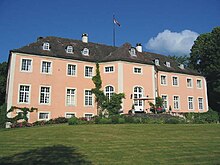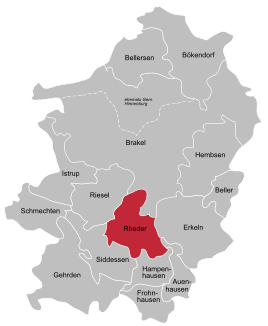Rheder (Brakel)
|
Rheder
City of Brakel
Coordinates: 51 ° 40 ′ 53 ″ N , 9 ° 9 ′ 49 ″ E
|
|
|---|---|
| Height : | 144 m |
| Area : | 8.86 km² |
| Residents : | 282 (Dec. 31, 2015) |
| Population density : | 32 inhabitants / km² |
| Incorporation : | January 1, 1970 |
| Postal code : | 33034 |
| Area code : | 05272 |
|
Location of Rheder in Brakel
|
|
Rheder is a district of the East Westphalian town of Brakel in the Höxter district with 282 inhabitants (as of December 31, 2015). For centuries the place was connected to the noble von Mengersen family as a knight seat .
geography
Rheder is located in the valley of the Nethe on the federal road 252 . Rheder belongs to the district of Höxter , the easternmost district in North Rhine-Westphalia . The lowest point of the district is the river bed of the Nethe near Brakel at around 140 meters above sea level .
history
Rheder has belonged to the secular rule of the Diocese of Paderborn , originally in the Duchy of Saxony , since its foundation . From the 14th century, the territory of the prince-bishopric of Paderborn ( Hochstift ) was formed in the Holy Roman Empire , and from the 16th century it belonged to the Lower Rhine-Westphalian Empire . In 1802/03 the bishopric was occupied by the Kingdom of Prussia . In Napoleonic times, the place was part of the canton of Gehrden in the Kingdom of Westphalia . From 1815 Rheder finally belonged to the Kingdom of Prussia, from 1871 it was part of the German Empire . 1945–1949 Rheder was part of the British occupation zone , from 1946 part of North Rhine-Westphalia and from 1949 also part of the Federal Republic of Germany .
On January 1, 1970 Rheder was incorporated into the city of Brakel.
Culture and sights
Buildings
Parish Church of St. Catherine
The catholic was built. Parish church of St. Katharina in 1716 probably by Gottfried Laurenz Pictorius on behalf of Burkard von Mengersen, with Johann Conrad Schlaun being entrusted with the completion of the building. The middle picture of the high altar is by Johann Martin Pictorius (1718) and shows the Holy Family. There is also a painting by the Paderborn painter Anton Joseph Stratmann : "Vision of St. John of Matha and blessed Felix of Valois" (southern triumphal arch pillar). On the right side in the interior is the epitaph for Hermann von Mengersen from the year 1585.
The organ was built in 1692. The organ builder is unknown. After several modifications and extensions, the instrument was largely restored to its original state in 2003. The historical pipe material has largely been preserved, as well as the organ case and wind chests. The instrument has 9 Manual register (Principal 8 ', Salicional 8', viol 8 ', Gedackt 8', Octave 4 ', Gedackt 4', octave 2 ', fifth, 1 1 / 3 ' and mix III), and a pedal stop (Subbass 16 ′).
Rheder Castle

The Rheder Castle , ancestral home of the family Mengersen was built in 1750 and is located between the Nethe in the west and the bailey to the east, the brewery is in the.
Antoinettenburg
The Vorwerk located between Rheder and Erkeln on the Herzberg was named after Sophie-Antoinette. Named Freiin Spiegel zum Desenberg. This building is popularly called Nettenburg.
Trumpet Jump
The trumpet jump, a steep rock face above the Nethe in the direction of Brakel, is popularly associated with a legend from the Thirty Years War . A memorial stone with a bronze plate donated by Adolf Freiherr Spiegel von und zu Peckelsheim was erected at this point. The legend goes:
At that time when robbery and hatred and sword
ravaged the German fatherland three times ten years
There lives in Rheder's quiet hut
A man in the
middle of his childhood,
The Behler was called, who
nourishes his honestly and diligently , he was a respectable old man .
Once he was torn from his wife's arm.
The enemies' wild
swarm of riders.
The village was already in full glow
. The poor blood was shed.
As a man, Behler spoke, pleaded and pleaded,
averting wisely many evil deeds.
Then he became the enemy of the black deeds blackest perpetrator,
a villain, he serves the enemy as a trumpeter.
His armor is covered by a tiger heart.
He was robbed of lust and murder was a joke.
Full of anger he grabbed the old man's hand
And tied him to the horse's tail
As if he wanted to drag him to
death over mountains and valleys for greater agony .
But suddenly the youth's blood warmed the
good old farmer's courage.
He tore himself loose with a strong hand
And here on this edge of the abyss, he
pushed down with a powerful push
Den Wüterich and his snorting horse.
So the bold courage of the man's highest treasure
was consecrated by him, the place is still called "trumpeter jump".
Often, in quiet midnight,
When the wanderer wakes up lonely,
When listening to lovely nightingales
He also listens to the wave that breaks on the rock,
Then he hears fearful deaths
It is the ghost of that villain
Often it sounds like the sound of a trumpet
And often like eagle owl's funeral song.
The poem comes from Pastor Joh. Franziskus Springer († 1814).
economy
The more than 300-year-old castle brewery Rheder with approx. 25 employees is located in Rheder . It was founded in 1686. 30,000 hectoliters are brewed in this brewery every year. These include Rheder-Pils, Rheder-Export, Husaren-Trunk, Annen-Dunkel, Bock and Doppelbock. The malting barley is grown in the attached estate. The estate includes 2.3 km² of agricultural area and 4.7 km² of forest.
Web links
- Rheder (Brakel) in the Westphalia Culture Atlas
Individual evidence
- ↑ http://www.brakel.de/Stadt/Portrait/Ortschaften/Rheder
- ↑ Martin Bünermann: The communities of the first reorganization program in North Rhine-Westphalia . Deutscher Gemeindeverlag, Cologne 1970, p. 108 .
- ↑ Hans Josef Böker : The builder of the parish church of Rheder . In: Yearbook 1994 of the district Höxter, pp. 155–160.
- ↑ To the organ of the parish church






